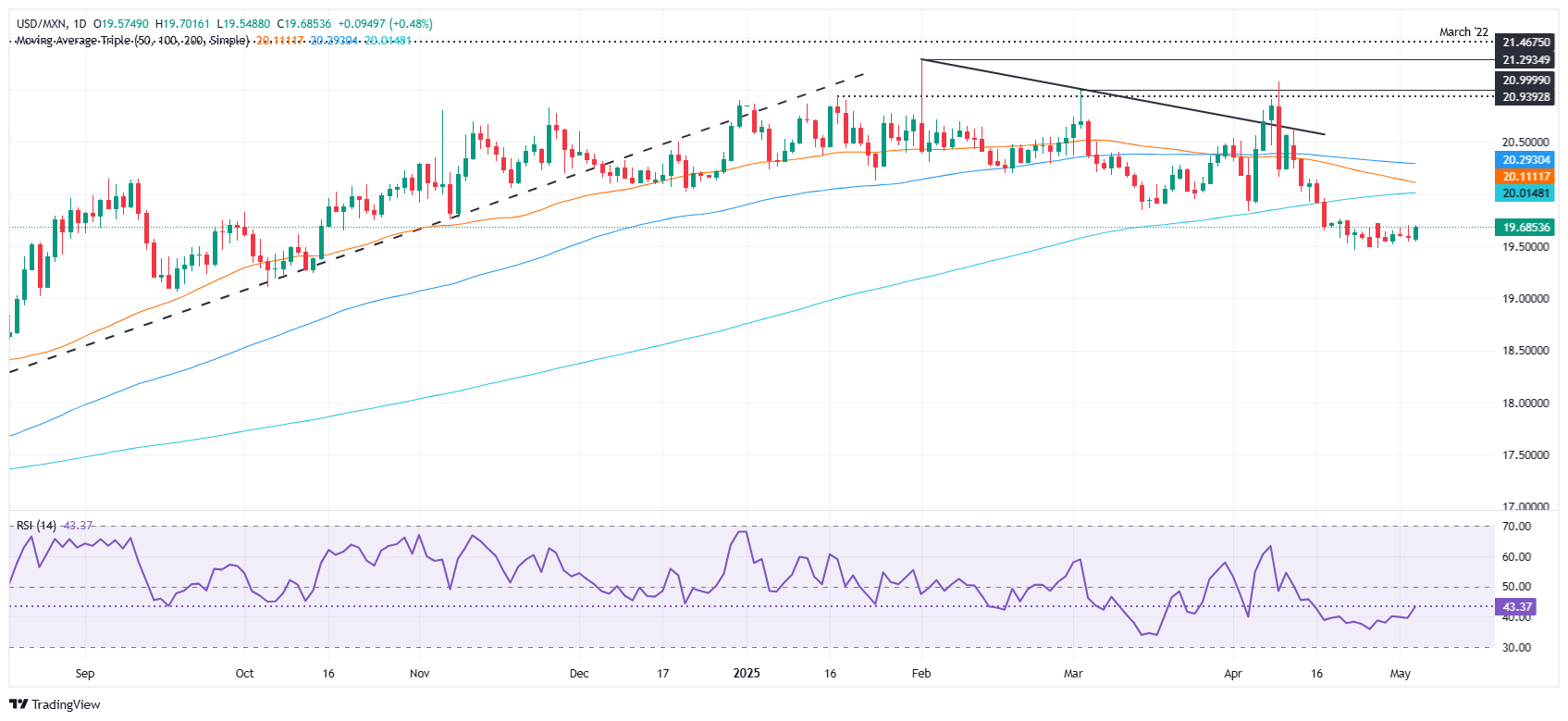- The Mexican peso falls 0.58% while the market prepares for the Fed meeting and April inflation data in Mexico.
- Banxico faces pressure if the CPI is re-acelera; Current inflation is maintained within the target range.
- The tensions between the US and Mexico increased after a report on a proposal for military incursion rejected to combat cartels.
The Mexican peso (MXN) began the week with losses of around 0.58% against the US dollar (USD) in a crucial week with the Federal Reserve (Fed) preparing to celebrate its monetary policy meeting on May 7 and the announcement of Mexico’s inflation data. At the time of writing, the USD/MXN is quoted in 19.67.
Market participants continued to digest news to the US trade, with Washington pointing out possible agreements with India, South Korea and Japan. Although the president of the United States, Donald Trump, said that China wants an agreement “very desperately,” Beijing’s lack of confirmation about the start of discussions keeps investors on alert.
Mexico’s economic agenda on Monday was absent, with the pending operators of the publication of the April 8 Consumer Price Index (CPI) on May 8. In March, inflation stood at 3.8% year -on -year and the underlying CPI at 3.64%. Although prices were maintained within the 3% or less range of the Bank of Mexico (Banxico), a new re-acelling would exert pressure on Banxico, which initiated a relaxation cycle.
In other news, Reuters revealed that the president of Mexico, Claudia Sheinbaum, and the US president Donald Trump, discussed an US military incursion in Mexico to combat drug cartels. However, Sheinbaum rejected the offer, saying in an event: “We can work together, but you in your territory and us in ours.”
On the other side of the border, the Supply Management Institute (ISM) revealed that the service activity improved in April. A subcomponent of the reading suggested that US companies reported an increase in paid prices.
The USD/MXN also remains sensitive to changes in the mood of the market. The operators are attentive to the monetary policy of the Fed, with expectations that the US Central Bank keeps the rates without changes. However, the operators are pending the tone of the president of the Fed, Jerome Powell, at the press conference after the meeting.
Daily summary of market movements: USD/MXN remains close to 19.70 in the face of the general weakness of the weight
- With the next decision of the Federal Reserve in sight, the difference in interest rates between the two countries could influence the direction of the USD/MXN. Hard maintenance of the Fed and a Powell restrictive position could weaken the emerging market currency (EM), raising the exchange rate, with the simple mobile average (SMA) of 200 days in the spotlight in 19.98.
- The ISM services PMI rose to 51.6 in April, from 50.8 and exceeding 50.6 expectations, pointing out a modest improvement in the activity of the services sector.
- Notably, the subscript of paid prices shot at 65.1-His highest level since February 2023-Subjecting from 60.9, indicating a re-acelling in inflationary pressures of inputs.
- The inflation data of Mexico, which were softer than expected, could influence Banxico to reduce rates at the May 15 meeting. Banxico has reduced rates by 100 basic points (PBS) in the last meetings, and most analysts surveyed by Citi Mexico project another 50 -page rate reduction. This would reduce the difference in interest rates between Mexico and the US, which until now favors the latter.
- Although the last figures of the Gross Domestic Product (GDP) of Mexico surprised the markets, with the economy dodging a technical recession, tariffs imposed on Mexican products, a reduced budget and geopolitical uncertainties will continue to stress the country’s finances and influence weight.
Technical perspective of the USD/MXN: The Mexican weight remains bullish while the USD/MXN is maintained below the 200 -day SMA
The downward trend of the USD/MXN remains intact, but it seems that the torque has found its foot, playing bottom near the range of 19.46–19.50, with sellers unable to push prices down. Buyers are gaining impulse, as reflected in the relative force index (RSI); Therefore, a 200 -day SMA test in 19.98 is on the horizon. A rupture of this last will expose the 20.00 mark, followed by the 100 -day SMA in 20.26.
On the contrary, if the USD/MXN falls below 19.46, it could exacerbate a drop towards the 19.00 mark, before the support converted into resistance of June 28 in 18.59.

Mexican weight FAQS
The Mexican weight (MXN) is the most commercialized currency among its Latin American peers. Its value is widely determined by the performance of the Mexican economy, the country’s central bank policy, the amount of foreign investment in the country and even remittance levels sent by Mexicans living abroad, particularly in the United States. Geopolitical trends can also affect MXN: for example, the Nearshoring process (or the decision of some companies to relocate the manufacturing capacity and supply chains closer to their countries of origin) is also considered a catalyst for the Mexican currency, since the country is considered a key manufacturing center in the American continent. Another catalyst for MXN is oil prices, since Mexico is a key exporter of the raw material.
The main objective of the Central Bank of Mexico, also known as Banxico, is to maintain inflation at low and stable levels (in or close to its 3%target, the midpoint of a tolerance band between 2%and 4%). To do this, the bank establishes an adequate level of interest rates. When inflation is too high, Banxico will try to control it by raising interest rates, which makes the indebtedness of homes and companies more cooling, thus cooling the demand and the economy in general. The highest interest rates are generally positive for Mexican weight (MXN), since they lead to higher yields, which makes the country a more attractive place for investors. On the contrary, lower interest rates tend to weaken the MXN.
The publication of macroeconomic data is key to evaluating the state of the economy and can have an impact on the valuation of the Mexican weight (MXN). A strong Mexican economy, based on high economic growth, low unemployment and high confidence is good for MXN. Not only attracts more foreign investment, but it can encourage the Bank of Mexico (Banxico) to increase interest rates, particularly if this fortress is accompanied by high inflation. However, if the economic data is weak, the MXN is likely to depreciate.
As an emerging market currency, the Mexican weight (MXN) tends to rise for periods of risk, or when investors perceive that the general market risks are low and, therefore, are eager to participate in investments that carry a higher risk. On the contrary, the MXN tends to weaken at times of market turbulence or economic uncertainty, since investors tend to sell higher risk assets and flee to the most stable safe shelters.
Source: Fx Street
I am Joshua Winder, a senior-level journalist and editor at World Stock Market. I specialize in covering news related to the stock market and economic trends. With more than 8 years of experience in this field, I have become an expert in financial reporting.







